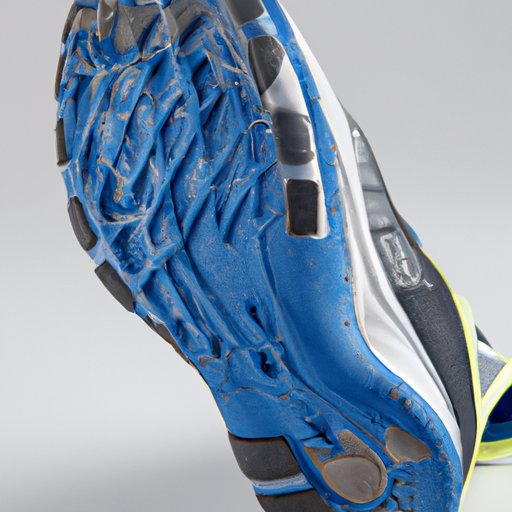Introduction
Running shoes are an essential piece of equipment for any runner, and it’s important to make sure they are in good condition so you can get the most out of your runs. Knowing how to tell if your running shoes are worn out is essential in order to ensure that your shoes provide you with the best performance and comfort. But what exactly does “worn out” mean?
When it comes to running shoes, “worn out” typically refers to a combination of factors such as excessive wear and tear, lack of cushioning, tears or holes in the upper material, excessive bending or creasing, frayed laces, and midsole cracking or separation. In this article, we will explore these topics in more detail and provide tips on how to tell if your running shoes are worn out.

Check the Tread for Wear and Tear
The first step in determining whether your running shoes are worn out is to check the tread for any signs of wear and tear. The tread is the part of the shoe that comes into contact with the ground and it’s important to make sure that it is not overly worn down. Common signs of wear and tear include thinning of the tread, loss of grip, and flat spots.
It’s also important to note that many running shoes have a specific pattern on the tread that can help indicate when the shoe is worn out. If you notice that the pattern is starting to disappear, then it’s a good indication that the shoe is nearing the end of its lifespan. Checking the tread on your running shoes regularly will help you determine when it’s time to invest in a new pair.
Feel for Any Cushioning Left in the Sole
Cushioning is an important aspect of running shoes and it helps provide protection from the impact of running. Over time, the cushioning in running shoes can start to break down and lose its effectiveness. To check for cushioning, place your hand inside the shoe and press it against the sole. If you can feel any cushioning, then the shoe still has some life left in it. If not, then it’s likely time to invest in a new pair.
It’s also important to note that some running shoes have different levels of cushioning depending on the type of terrain you plan to run on. If you plan to run on pavement or trails, then you’ll want to look for a shoe with more cushioning. If you plan to run on dirt or grass, then you may want to opt for a shoe with less cushioning.

Look for Any Tears or Holes in the Upper Material
The upper material of a running shoe is the part that covers the top of your foot and it’s important to make sure it is in good condition. Different types of upper materials can be used in running shoes such as mesh, leather, and synthetic materials. Over time, these materials can start to break down and develop tears or holes.
To check for tears or holes, take a close look at the upper material of your shoe. If you notice any tears or holes, then it’s time to invest in a new pair. It’s also important to note that some running shoes come with additional features such as gussets or overlays which can help protect the upper material from wear and tear.
Identify Any Signs of Excessive Bending or Creasing
Another common sign that a running shoe is worn out is excessive bending or creasing. This can occur when the sole of the shoe is worn down due to frequent use and can cause the shoe to bend or crease in certain areas. To identify any signs of excessive bending or creasing, take a look at the bottom of the shoe and check for any unusual bends or creases.
If you notice any signs of excessive bending or creasing, then it’s likely time to invest in a new pair of running shoes. It’s also important to note that some running shoes come with additional features such as carbon fiber plates or flex grooves which can help reduce bending and creasing.
Examine the Laces for Fraying
The laces of a running shoe can be prone to fraying over time due to regular use. To check for fraying, take a look at the laces and look for any signs of fraying or unraveling. If you notice any fraying, then it’s likely time to invest in a new pair of laces.
It’s also important to note that some running shoes come with additional features such as reinforced eyelets or locking laces which can help reduce fraying and keep your laces in better condition for longer.

Observe the Midsole for Any Signs of Cracking or Separation
The midsole of a running shoe is responsible for providing cushioning and support, and it can start to crack or separate over time due to regular use. To check for any signs of cracking or separation, take a close look at the midsole and look for any cracks or separations. If you notice any signs of cracking or separation, then it’s likely time to invest in a new pair of running shoes.
Conclusion
In this article, we explored several topics related to how to tell if running shoes are worn out. We discussed the importance of checking the tread for wear and tear, feeling for any cushioning left in the sole, looking for any tears or holes in the upper material, identifying any signs of excessive bending or creasing, examining the laces for fraying, and observing the midsole for any signs of cracking or separation. By following these steps, you’ll be able to determine when it’s time to invest in a new pair of running shoes and get the most out of your runs.


